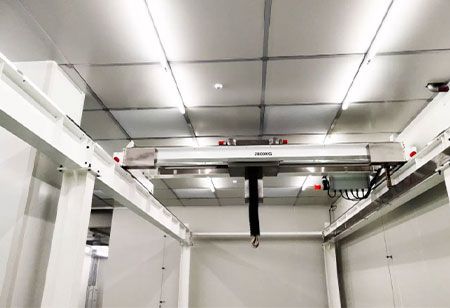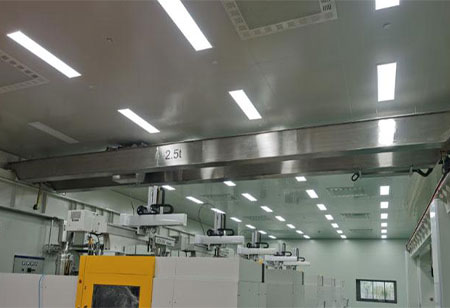Kuldeep Singh, Content Writer | Friday, 09 August 2024

In today’s rapidly evolving technological land- scape and the growing intersection of indus- tries, the seemingly unrelated fields of bio- pharmaceuticals, stainless steel, and cranes actually hold significant potential for innovation and collaboration. This article will delve into how these three areas are intermingling and the potential future transformations such cross-sector integration may bring.
I. Biopharmaceuticals and Stainless Steel: Resonance of Quality and Safety
Biopharmaceuticals, crucial for human health, demand exceptionally high standards of product quality and safety. In this field, even minor quality issues can have serious consequences. Thus, selecting the right materials is vital. Stainless steel, known for its high quality, corrosion resistance, ease of cleaning, and contamination prevention, has become an indispensable material in the biopharmaceutical sector.
In the manufacturing of pharmaceutical equipment, the durability and stability of stainless steel ensure safety and reliability over extended periods. Particularly in drug production, stainless steel equipment effectively prevents chemical reactions between drugs and equipment surfaces, ensuring drug purity and safety. Stainless steel is widely used in surgical instruments and laboratory construction because of its smooth surface, easy to clean and the ability to minimize the risk of cross-contamination. Therefore, stainless steel lifting products dominated by cleanroom cranes are also widely used in surgical instruments and laboratory construction.
By understanding the specific needs of the biopharmaceutical sector, the stainless steel industry can continuously optimize product performance and processes, enhancing quality standards. For example, as technology advances, the corrosion resistance and high-temperature performance of stainless steel can be further improved to meet stricter industry requirements. Conversely, innovations in biopharmaceuticals can drive advancements in stainless steel technology, offering high-quality products for various applications.
II. Cranes and Biopharmaceuticals: Cross-Sector Smart Manufacturing Collaboration
Cranes, essential in industrial production, are increasingly finding applications in the biopharmaceutical field. In pharmaceutical plants and laboratories, high-precision cranes can ensure accurate material handling and equipment positioning during production. This accuracy is crucial for maintaining production efficiency and product quality.
For instance, in drug production, cranes can be used to transport heavy raw materials and finished products, ensuring smooth material flow on production lines. The application of smart cranes can enhance automation and intelligence in production processes. By integrating advanced sensors and control systems, smart cranes can monitor production conditions in real-time, automatically adjust operation parameters, increase efficiency, reduce labor costs, and minimize human errors.
DAFANG CRANE recently developed a new clean room crane. In the API processing plant, the role of the lifting equipment is mainly reflected in the following aspects:
 In general, dust-free cranes, with their unique structure and functions, provide an efficient, safe and environmentally friendly production method for API processing plants.In the future, with the development of the pharmaceutical industry and the progress of technology, we believe that dust-free cranes will be applied and promoted in more fields, bringing more convenience and safety to human production and life.
In general, dust-free cranes, with their unique structure and functions, provide an efficient, safe and environmentally friendly production method for API processing plants.In the future, with the development of the pharmaceutical industry and the progress of technology, we believe that dust-free cranes will be applied and promoted in more fields, bringing more convenience and safety to human production and life.
Further more, smart cranes can enable more functions in the biopharmaceutical industry, such as automated storage and retrieval systems. These systems effectively reduce manual inter- vention, improve operational efficiency, and lower operating costs by optimizing material flow. By collaborating with the biopharmaceutical sector, crane manufacturers can gain deeper insights into the actual needs of production processes and develop intelligent equipment tailored to industry-specific requirements.
III. Cross-Sector Integration: A New Trend for the Future of Biopharmaceuticals
As technology continues to advance, the cross-sector integration of biopharmaceuticals, stainless steel, and cranes is set to become a significant trend in future development. This integration not only drives technological progress in each field but also fosters new business models and industry ecosystems.
Firstly, combining the superior characteristics of stainless steel with the needs of biopharmaceuticals can lead to the development of safer and more efficient pharmaceutical equipment and medical devices. For example, stainless steel materials can be integrated with advanced biotechnology to create more durable and functional medical devices, improving treatment outcomes while better protecting patient health.
Secondly, the application of smart cranes will advance automation and intelligence in the biopharmaceutical industry. By achieving intelligent management of production processes, the biopharmaceutical sector can enhance production efficiency and product quality, further advancing the industry. Additionally, cross-sector integration can give rise to new business models and industry ecosystems. For example, cross-industry innovation platforms can be established to gather technology, talent, and resources from biopharmaceuticals, stainless steel, and cranes to drive cross-sector technology development and application. Such platforms will promote inter-industry collabo- ration, accelerate the transformation and application of technological achievements, and drive the upgrading and development of the entire industry chain.
Conclusion
In summary, although biopharmaceuticals, stainless steel, and cranes may seem unrelated, their cross-sector integration holds significant potential for innovation and collaboration. By combining technologies and resources from these fields, we can provide safer, more efficient, and intelligent solutions for the biopharmaceutical industry and promote overall industry progress and development. This integration not only fosters technological advance- ment but also creates new business opportunities, injecting fresh momentum into future development.